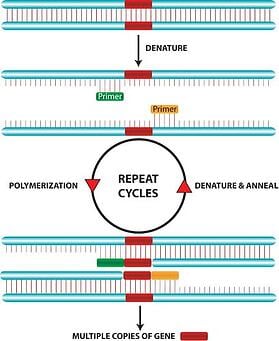Question:
How different strains of and organisms can be identified using Polymerase Chain Reaction?
The Protein Man Says:
In some environmental samples, specifically water samples, harmful pathogens may exist, but only in small concentrations that make them very hard to isolate and identify. When researchers need to amplify a sample of pathogenic DNA for identification and examination, the PCR, or polymerase chain reaction, provides a fast and accurate solution.
The Polymerase chain reaction (PCR), first envisaged in 1984 by Kary Mullis, has revolutionized life sciences and has become an essential technique in many aspects of science, including clinical diagnostics, forensics and genetic engineering. Kary Mullis eventually received the Nobel Prize in Chemistry in 1993.
 Not only can the PCR assay be used to identify infectious disease organisms, it can also be used to identify variations and mutations in genetic material. The PCR assay can help researchers magnify the genetic sequence in a DNA sample as small as a single cell, and may have applications across a wide variety of fields, from medicine to forensics to epidemiology. More than 60 protocols have been developed that use PCR to isolate small samples and identify pathogenic bacteria, viruses and fungi that cause diseases including AIDS, viral meningitis, herpes, Lymes disease, otitis media, and cancer causing strains of papilloma virus.
Not only can the PCR assay be used to identify infectious disease organisms, it can also be used to identify variations and mutations in genetic material. The PCR assay can help researchers magnify the genetic sequence in a DNA sample as small as a single cell, and may have applications across a wide variety of fields, from medicine to forensics to epidemiology. More than 60 protocols have been developed that use PCR to isolate small samples and identify pathogenic bacteria, viruses and fungi that cause diseases including AIDS, viral meningitis, herpes, Lymes disease, otitis media, and cancer causing strains of papilloma virus.
How Polymerase Chain Reaction Assay is Used in DNA Identification?
PCR utilizes the natural function of polymerase enzymes. In a normal dividing cell, the copying of the genes requires a series of enzyme mediated reactions:
-
The DNA strands are unwound (denatured) by enzymes to form two single strands.
-
A RNA polymerase binds and synthesizes a short complementary piece of RNA on the DNA strand at the initiation site of replication.
-
This DNA/RNA heteroduplex acts as a priming site for the DNA polymerase that binds and produces the complementary strand.
The key to the polymerase chain reaction was first discovered in 1976. The key is the Taq polymerase that was purified from the thermophile Thermus aquaticus. A thermophile is an organism that grows at extreme temperature (>100°C). The importance of the Taq polymerase being purified from a thermophile is that the enzyme will not be destroyed at high temperatures required to denature the DNA and allow PCR to begin.
There are three basic steps in PCR (see figure). First, the template DNA or genetic material is denatured; the strands of its helix are unwound and separated-by heating to 90-96°C. In a normal cell the DNA is unwound by specific enzymes.
The second step is hybridization or annealing. The Taq polymerase requires a short piece of RNA to initiate DNA replication, which in a normal cell is synthesized by the RNA polymerase. In the PCR reaction, short complimentary double stranded oligos are added that bind the denatured DNA and act as origins of replications. These double stranded oligos are known as primers and are complimentary to sequences up and down stream of the gene of interest. Two primers are used, one for each strand of DNA. Following denaturation, the reaction mixture is rapidly cooled to a temperature below the melting point of the specific primers (~55°C), below this temperature the primers bind to their complementary bases on the now single stranded DNA.
In the third step, the temperature of the reaction is raised to the optimal temperature for the polymerase (68-72°C). The polymerase synthesizes new DNA, starting from the primer, the polymerase reads a template strand and generates complementary nucleotides very quickly. The result is two new helixes in place of the first, each composed of one of the original strands plus its newly assembled complementary strand. PCR allows scientist to make unlimited copies of DNA fragments and genes from a single copy of initial DNA. Each cycle of the polymerase chain reaction doubles the number of copies of the gene of interest, so if 33 cycles are used, over 17 billion copies of your gene of interest will be made for each starting template!






